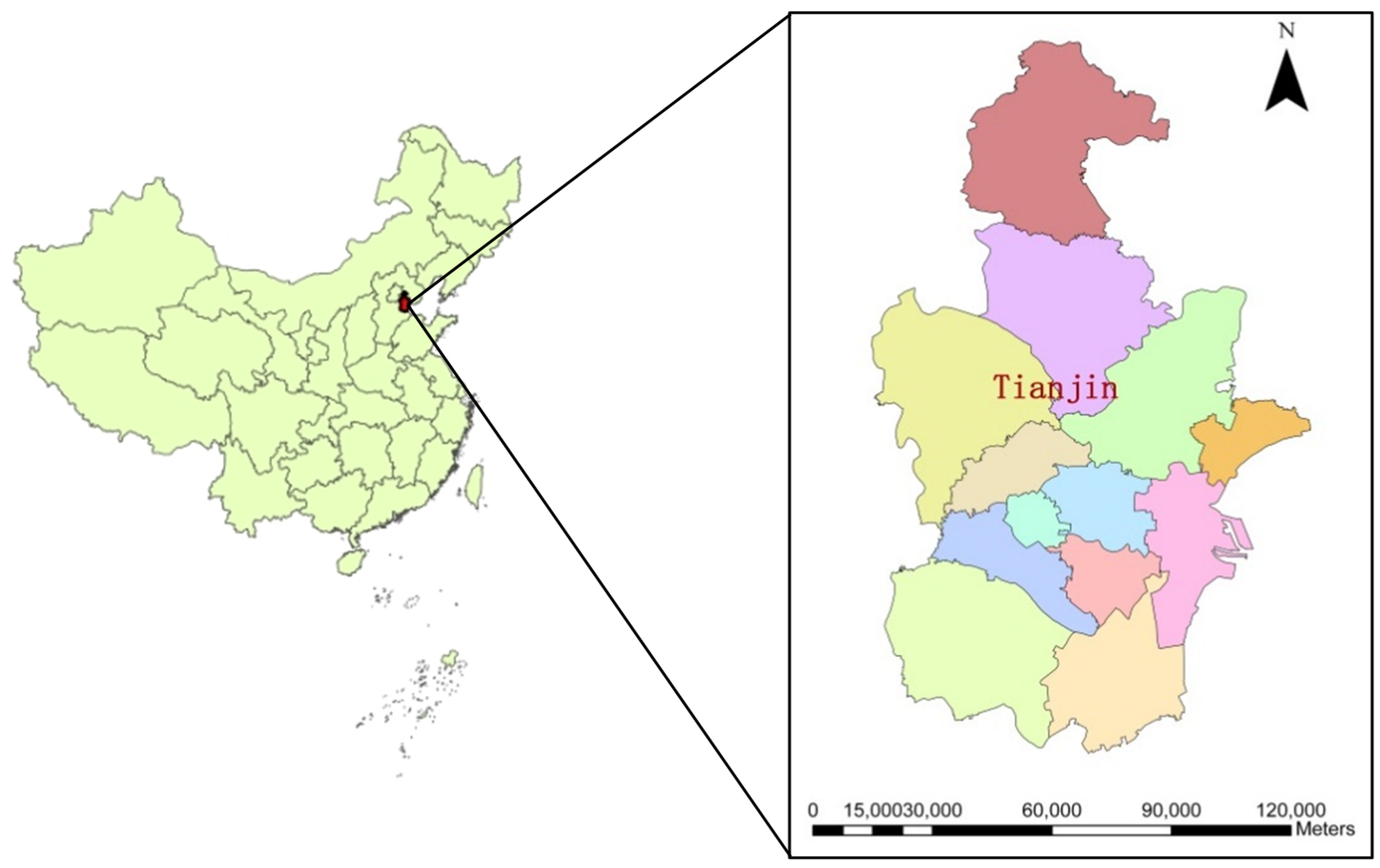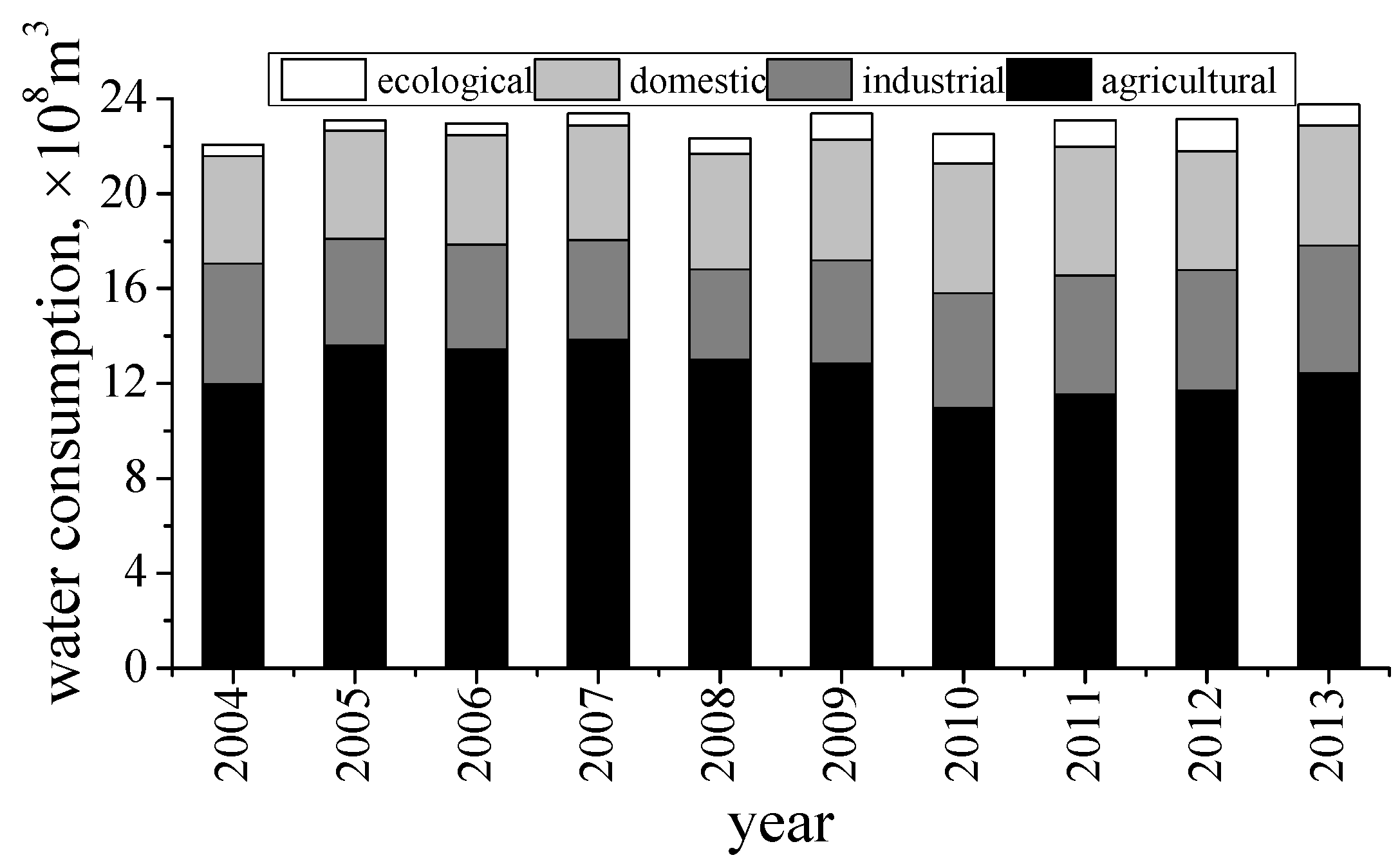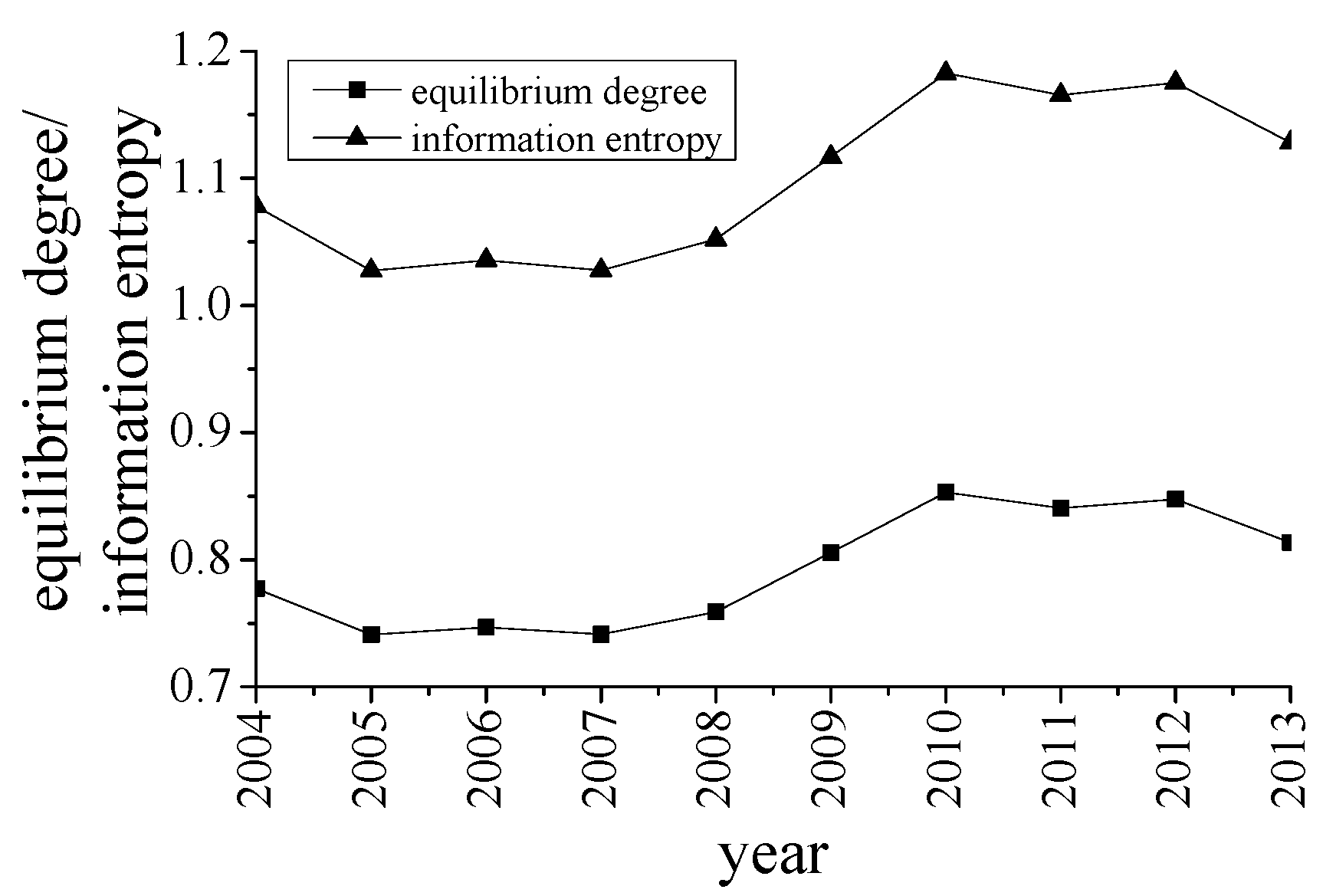Analysis on Impact Factors of Water Utilization Structure in Tianjin, China
Abstract
:1. Introduction
2. Material and Methods
2.1. Research Area
2.2. Data Source
3. Analysis Methods
3.1. Information Entropy Anasysis
3.2. Grey Correlation Analysis Method
4. The Water Consumption and Its Impact Factors
4.1. Agricultural Water Consumption
4.2. Industrial Water Consumption
4.3. Domestic Water Consumption
4.4. Ecological Water Consumption
5. The Evolution of Water Utilization Structure and Its Impact Factors
5.1. Water Utilization Structure Analysis
5.2. The Impact Factors Analysis of Water Utilization Structure
6. Conclusions
Acknowledgments
Author Contributions
Conflicts of Interest
References
- Liu, B.Q.; Yao, Z.J.; Gao, Y.C. Trend and driving forces of water consumed structure changes in Beijing. Resour. Sci. 2003, 25, 38–43. (In Chinese) [Google Scholar]
- Jenerette, G.D. A global perspective on changing sustainable urban water supplies. Glob. Planet. Chang. 2006, 50, 202–211. [Google Scholar] [CrossRef]
- Su, X.L.; Zhao, C.; Ma, L.H. Water consumed structure evolvement and its driving forces for Guanzhong Region in the past 20 years. J. Irrig. Drain. 2008, 27, 71–73. (In Chinese) [Google Scholar]
- Ma, L.H.; Kang, S.Z.; Su, X.L. Study on evolution and its driving forces of water utilization structure of Shiyang River Basin in northwest arid areas. Agric. Res. Arid Areas 2008, 26, 125–130. (In Chinese) [Google Scholar]
- Zheng, A.Q.; Wang, W.K.; Duan, L. Water consumption structure evolvement and its driving forces for Guanzhong Basin. J. Arid Land Resour. Environ. 2011, 25, 75–79. (In Chinese) [Google Scholar]
- Lv, C.M.; Wu, Z.N.; Hu, C.H. Grey relational degree analysis on the major driving forces of water use structure. Water Sav. Irrig. 2008, 2, 39–41. (In Chinese) [Google Scholar]
- Chen, X.F. Analysis of grey relation degree based on water utilization evolution and driving force of information entropy in Xiamen. J. Water Resour. Water Eng. 2013, 24, 188–191. (In Chinese) [Google Scholar]
- Yun, Y.; Zou, Z.H.; Wang, H.W. A regression model based on the compositional data of Beijing’s water consumed structure and industrial structure. Syst. Eng. 2008, 26, 67–71. (In Chinese) [Google Scholar]
- Liu, X.X.; Xie, J.C. The interactive relationship between water consumption structure and industrial structure of Shanxi Province. Syst. Eng. 2011, 29, 45–51. (In Chinese) [Google Scholar]
- Zhai, Y.Z.; Wang, J.S.; Zheng, J.Q.; Huan, H. Evolution and driving forces of water consumed structure in Beijng during the past 30 years. J. Nat. Resour. 2011, 26, 635–643. (In Chinese) [Google Scholar]
- Paola, F.D.; Fontana, N.; Galdiero, E.; Giugni, M.; Savic, D.; Uberti, G.S. Automatic multi-objective sectorization of a water distribution network. Procedia Eng. 2014, 89, 1200–1207. [Google Scholar] [CrossRef]
- Paola, F.D.; Fontana, N.; Galdiero, E.; Giugni, M.; Uberti, G.S.; Vitaletti, M. Optimal design of district metered areas in water distribution networks. Procedia Eng. 2014, 70, 449–457. [Google Scholar] [CrossRef]
- Paola, F.D.; Galdiero, E.; Giugni, M. A jazz-based approach for optimal setting of pressure reducing valves in water distribution networks. Eng. Optim. 2015. [Google Scholar] [CrossRef]
- Paola, F.D.; Galdiero, E.; Giugni, M.; Pugliese, F. Sustainable development of storm-water systems in African cities considering climate change. Procedia Eng. 2015, 119, 1181–1191. [Google Scholar] [CrossRef]
- Nunez, B.; Roman, J.E.P.; Souto, J.A.G. Decision support system for the optimal design of district metered areas. J. Hydroinf. 2015. [Google Scholar] [CrossRef]
- Marios, S. Global and regional water availability and demand prospects for the future. Nat. Resour. Res. 2004, 13, 61–75. [Google Scholar]
- Liu, C.; Bai, M.G. Change in industrial water use in Anhui Province based on LMDI. Resour. Sci. 2012, 34, 2299–2305. (In Chinese) [Google Scholar]
- Zhang, L.B.; Xu, Y.J.; Jin, J.L.; Wu, C.G. Analysis of influence factors of regional industry water use in Anhui Province. J. Hydraulic Eng. 2014, 45, 837–843. (In Chinese) [Google Scholar]
- Arbues, F.; Barberan, R.; Villanua, I. Price impact on urban residential water demand: A dynamic panel data approach. Water Resour. Res. 2004, 40, 1–9. [Google Scholar] [CrossRef]
- Cui, H.S.; Deng, Y.Q. Factors influencing residential water consumption. Water Resour. Prot. 2009, 25, 83–85. (In Chinese) [Google Scholar]
- Xu, H. Investigation on Influencing Factors of Domestic Water Use in Beijing; Capital Normal University: Beijing, China, 2012. (In Chinese) [Google Scholar]
- Tianjin Municipal Bureau of Statistics. Tianjin Statistical Yearbook 2005–2014; China Statistic Press: Beijing, China, 2005–2014. (In Chinese) [Google Scholar]
- Zhao, L.R.; Wu, J.W.; Yang, X.; Huang, Z.Q.; Li, H.Q. Analysis of influence factors of irrigation water quantity of Hetao Irrigation District based on analysis of variance. Water Sav. Irrig. 2009, 7, 1–3. (In Chinese) [Google Scholar]
- Liu, Z.X. Analysis on Water Demand Structure Change and Water Consumption Forecasting in Baotou; Northwest A & F University: Xi’an, China, 2013. (In Chinese) [Google Scholar]
- Xie, H.T. The Research of Water Resources Utilization and Its Influencing Factor Analysis in Hunan Province; Hunan University: Hunan, China, 2011. (In Chinese) [Google Scholar]
- Qin, H.Y. Performance Evaluation and Influence Factor Analysis of Agricultural Water of Ganzhou District: A Perspective of Farmer Water User Associations; Lanzhou University: Lanzhou, China, 2014. (In Chinese) [Google Scholar]
- Harun, R.; Muresan, I.C.; Arion, F.H. Analysis of factors that influence the willingness to pay for irrigation water in the Kurdistan Regional Government, Iraq. Sustainability 2015, 7, 9574–9586. [Google Scholar] [CrossRef]
- Mai, Z.Y.; He, Z.J.; Wang, X.H. Urban hourly water demand prediction based on principal factors analysis. J. Zhejiang Univ. (Eng. Sci.) 2012, 46, 1968–1974. (In Chinese) [Google Scholar]
- Liu, Y.F.; Kong, W. Analysis of industry water utilization change in Beijing based on factor decomposition model. Water Resour. Power 2013, 31, 26–29. (In Chinese) [Google Scholar]
- Wu, F.; Zhan, J.Y.; Zhang, Q. Evaluating impacts of industrial transformation on water consumption in the Heihe River Basin of Northwest China. Sustainability 2014, 6, 8283–8296. [Google Scholar] [CrossRef]
- Shi, Q.L.; Chen, S.Y.; Shi, C.C. The impact of industrial transformation on water use efficiency in Northwest Region of China. Sustainability 2015, 7, 56–74. [Google Scholar] [CrossRef]
- Sun, Y.; Xu, Z.X. Impact factors classification urban water consumption forecast and priority weight analysis for forecasting target. Energy Environ. Prot. (S1) 2008, 34, 114–117. (In Chinese) [Google Scholar]
- Tian, S.Y.; Li, X.C.; Yang, B.Z.; Qiu, Y.Q.; Wang, C.Y.; Du, J.K. Xi’an urban residents living water demand factors analysis. China Rural Water Hydropower 2014, 2, 35–37. (In Chinese) [Google Scholar]
- Cheng, Z.L.; Zuo, J.L.; Li, H.; Xu, Y.T.; Wang, L.; Wang, Z.P. Analysis of affecting factors for water consumption of new rural residents. Water Sav. Irrig. 2011, 10, 51–59. (In Chinese) [Google Scholar]
- Ma, D.C.; Xian, C.F.; Zhang, J. The evaluation of water footprints and sustainable water utilization in Beijing. Sustainability 2015, 7, 13206–13221. [Google Scholar] [CrossRef]
- Yan, J.J.; Sha, J.H.; Chu, X. Dynamic evaluation of water quality improvement based on effective utilization of stockbreeding biomass resource. Sustainability 2014, 6, 8218–8236. [Google Scholar] [CrossRef]
- Shannon, C.E. A mathematical theory of communication. Mob. Comput. Commun. Rev. 1948, 5, 3–55. [Google Scholar] [CrossRef]
- Zhang, S.L.; Zhang, G.L. Comparison of grey correlation calculation methods and its problem. Syst. Eng. 1996, 14, 45–49. (In Chinese) [Google Scholar]
- Deng, J.L. Foundation of Grey System; Huazhong University of Science and Technology: Wuhan, China, 2002; pp. 122–209. (In Chinese) [Google Scholar]
- Fan, J.G. The grey analysis on grain output and its main input elements in Shaanxi Province from 1983 to 2004. Agric. Res. Arid Areas 2007, 25, 209–212. (In Chinese) [Google Scholar]
- Lei, H.; Zhang, X. Anslysis on water use structure change and its driving forces during last 10 years in Shaanxi Province. J. Water Reour. Water Eng. 2012, 23, 125–128. (In Chinese) [Google Scholar]



| Water consumption | Impact factor |
|---|---|
| Agricultural water consumption | canal lining [23], canal facilities [23], water management [23], planting structure adjustment [23], rainfall [23], cultivated area [4,24], climate factors [4] , grain yield [25], water-saving effect [26], water price [26], irrigation area [26,27] |
| Industrial water consumption | industrial water saving [18], economic scale [17,18], industrial structure [17,18], water intensity [17,18], quota effect [17], population effect [24,28], technology effect [29], water reuse efficiency in industry [24,28], gross industrial output value [24,30], GDP [24], fixed assets investment [24,31] |
| Domestic water consumption | population [32], water saving model [22], price [32], economy development [32], regional difference [32], municipal infrastructure [32], the lowest temperature [28], the maximum and minimum humidity [32], green coverage of built-up area [24], living space per capita [33], consciousness of water saving [34], family income [21], water price [4,35] |
| Ecological water consumption | per capita green area [8,36] |
| Correlation Degree | Correlation Degree | ||
|---|---|---|---|
| Cultivated area | 0.7357 | Forestry output value | 0.6921 |
| Effective water saving irrigation area | 0.6571 | Animal husbandry output value | 0.7087 |
| Effective irrigation area | 0.6699 | Fishery output value | 0.4901 |
| Agricultural output value | 0.6642 | Rural electricity consumption | 0.7071 |
| Industrial output value | Water consumption of ten thousand CNY industrial output value | Water consumption of ten thousand CNY industrial added value | Light industry output value | Heavy industry output value | High technology industry output value | |
|---|---|---|---|---|---|---|
| Correlation degree | 0.6768 | 0.7144 | 0.7520 | 0.7056 | 0.6645 | 0.6786 |
| Resident population | Urban per capita income | Per capita domestic water consumption | |
|---|---|---|---|
| Correlation degree | 0.7375 | 0.6898 | 0.6806 |
| Per capita green area | Garden green area | Park area | |
|---|---|---|---|
| Correlation degree | 0.4946 | 0.7052 | 0.6414 |
| Correlation degree | 0.6787 | 0.6326 | 0.6295 | 0.7478 | 0.6636 | 0.6420 | 0.7434 | 0.6417 | 0.7024 | 0.7726 |
| Correlation degree | 0.7201 | 0.7383 | 0.7301 | 0.7126 | 0.6804 | 0.7151 | 0.6690 | 0.6653 | 0.7446 | 0.6934 |
© 2016 by the authors; licensee MDPI, Basel, Switzerland. This article is an open access article distributed under the terms and conditions of the Creative Commons by Attribution (CC-BY) license (http://creativecommons.org/licenses/by/4.0/).
Share and Cite
Zhang, C.; Dong, L.; Liu, Y.; Qiao, H. Analysis on Impact Factors of Water Utilization Structure in Tianjin, China. Sustainability 2016, 8, 241. https://doi.org/10.3390/su8030241
Zhang C, Dong L, Liu Y, Qiao H. Analysis on Impact Factors of Water Utilization Structure in Tianjin, China. Sustainability. 2016; 8(3):241. https://doi.org/10.3390/su8030241
Chicago/Turabian StyleZhang, Conglin, Leihua Dong, Yu Liu, and Haijuan Qiao. 2016. "Analysis on Impact Factors of Water Utilization Structure in Tianjin, China" Sustainability 8, no. 3: 241. https://doi.org/10.3390/su8030241
APA StyleZhang, C., Dong, L., Liu, Y., & Qiao, H. (2016). Analysis on Impact Factors of Water Utilization Structure in Tianjin, China. Sustainability, 8(3), 241. https://doi.org/10.3390/su8030241





